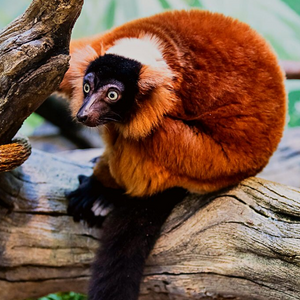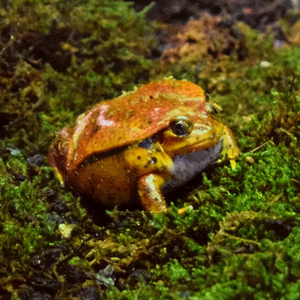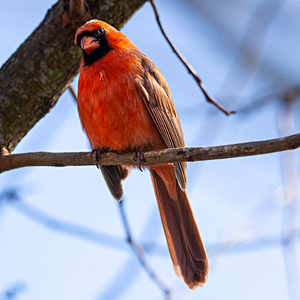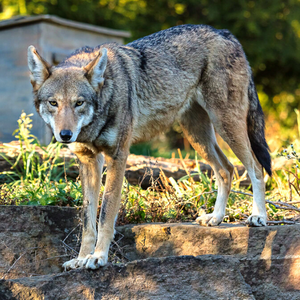Redheads may be known for being wild, but there are none wilder than the "gingers” at your Akron Zoo. As a matter of fact, we are home to several red species, who have all adapted to have their coloration for different reasons. Read on to learn about these unique animals and their fiery coloring!
Red Ruffed Lemurs
 Red ruffed lemurs are some of the largest pollinators in the world, and the largest lemurs in Madagascar to walk on four legs. Their thick fur is a chestnut color, though its purpose is less about color and more about function. Red ruffed lemurs have dense fur that creates a waterproof coat, protecting them from the rainy and sometimes cold conditions of the forest canopy.
Red ruffed lemurs are some of the largest pollinators in the world, and the largest lemurs in Madagascar to walk on four legs. Their thick fur is a chestnut color, though its purpose is less about color and more about function. Red ruffed lemurs have dense fur that creates a waterproof coat, protecting them from the rainy and sometimes cold conditions of the forest canopy.
Your Akron Zoo is home to four red ruffed lemur sisters, Avatar, Gwen, Ikoto and Zeke (pronounced Zeh-kay). Gwen is the oldest from a previous litter while the other three are triplets. The girls love to bask in the sun in their outdoor yard, or participate in trainings with their keepers for sweet treats, such as honey and fruit.
Tomato Frog
“What happens when an ambiguously categorized fruit and a tropical amphibian fall in love?” jokes keeper Dan Remski. “You get a tomato frog.” 
There are more than 300 species of frogs found in Madagascar, a majority of which cannot be found anywhere else on the planet, including three species of tomato frog. These frogs are named after their bright red-orange coloration and exceptionally round bodies. Like most brightly colored amphibians, the tomato frog’s color acts as a warning to potential predators that they are toxic and would not make a pleasant snack. Since they don’t have to worry about being eaten by predators, tomato frogs spend most of their time partially buried under piles of leaves, waiting to ambush small insects or worms with their sticky tongue.
“At the zoo we currently have one tomato frog on habitat who happens to be very old,” says Remski. “We also have three young frogs in quarantine: Beefsteak, Heirloom, and Roma, who will hopefully be in the public habitat in the near future.”
Red Pandas
 Red pandas have always been a guest favorite at the Akron Zoo. The zoo is currently home to three panda sisters: Coco, Lulu and Penny. These girls spend most of their days napping or munching on bamboo. Currently Coco is the most dominant of the three. Lulu is still very interested in interacting with keepers. Penny is currently the shyest.
Red pandas have always been a guest favorite at the Akron Zoo. The zoo is currently home to three panda sisters: Coco, Lulu and Penny. These girls spend most of their days napping or munching on bamboo. Currently Coco is the most dominant of the three. Lulu is still very interested in interacting with keepers. Penny is currently the shyest.
"The red coloring of our pandas is actually part of their camouflage in their native habitat. It matches a type of moss that grows in the foothills of the Himalayas," says principal red panda keeper, Lisa Melnik. "In 2016 I was able to travel to eastern Nepal with the Red Panda Network, and I can personally attest to the fact that when a panda is curled up in a tree, it’s pretty much impossible to tell the difference between the panda and a clump of moss.”
Cardinal
 Fashion magazines will tell you that wearing red helps you look sharp, and many bird species would agree. Several male birds, including cardinals, use their bright red plumage to find a mate, and birds with the most vivid plumage have the most breeding success. This might sound a bit superficial of the female cardinals, but research shows that there is actually a biological benefit to this selection process.
Fashion magazines will tell you that wearing red helps you look sharp, and many bird species would agree. Several male birds, including cardinals, use their bright red plumage to find a mate, and birds with the most vivid plumage have the most breeding success. This might sound a bit superficial of the female cardinals, but research shows that there is actually a biological benefit to this selection process.
Male cardinals are red due to carotenoid pigment found in the seeds and fruit they eat. Bright coloring indicates a healthy mitochondrion, and males with more vivid plumage also tend to have better immunity, improved winter heartiness, greater foraging ability and skill at avoiding predators.
“The Akron Zoo is home to one male cardinal who first arrived in October of 2012,” says keeper Mallory Balmert. “He enjoys waxworms, sunflower seeds and defending his territory during breeding season from the other birds in the Aviary. He also sings pretty frequently.”
Red Wolves
 Some of the zoo’s youngest redheads are our red wolf pups, born on April 22, 2021. Mom, Juno, and dad, Waya, have been doing a great job of parenting their very first litter, and the four pups living at the Akron Zoo are happy and healthy.
Some of the zoo’s youngest redheads are our red wolf pups, born on April 22, 2021. Mom, Juno, and dad, Waya, have been doing a great job of parenting their very first litter, and the four pups living at the Akron Zoo are happy and healthy.
Unfortunately, the reddish color of the red wolf’s fur has played a role in making this species the most endangered canid in the world. Red wolves are often mistaken for coyotes, who have a similar coloration and can pose a threat to livestock and pets. Extreme predator control programs and hunting of both species has brought red wolves to the brink of extinction, with fewer than 20 individuals in their native habitat today. However, the Akron Zoo has been able to partner with U.S. Fish and Wildlife Services to cross foster four of Juno’s original eight pups in their native habitat, improving genetic diversity and increasing the native population.
We hope you will stop by the zoo to visit our wild redheads, as well as the more than 1000 animals who come in every color of the rainbow!
